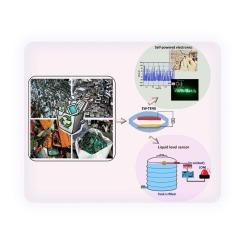A sustainable approach to energy generation from recycled capacitors and batteries: intelligent fluid monitoring device
IF 4.6
3区 材料科学
Q2 MATERIALS SCIENCE, MULTIDISCIPLINARY
引用次数: 0
Abstract
The rapid rise in electronic waste (e-waste) necessitates sustainable energy and waste valorization strategies. This study presents an e-waste-based triboelectric nanogenerator (EW-TENG) using upcycled components, aluminium electrolytic capacitors, Metallized Polypropylene Self-Healing (MPP-SH) capacitors, and lithium/zinc-ion batteries. Classified as film or powder-based, these materials were integrated with polyvinyl alcohol (PVA) to form composite films, serving as tribopositive layers against polyvinylidene fluoride (PVDF) in a vertical contact-separation mode. Aluminium (Al) foil and recycled polyethylene terephthalate (PET) were used as electrodes and substrate, respectively. The optimized EW-TENG produced an output of 274.40 V, 12.32 μA, and a peak power of 144.30 mW at 130 MΩ. It successfully powered 70 LEDs and a digital wristwatch, and also operated as a liquid-level sensor via a floating electrode mechanism. This multifunctional device offers a sustainable, low-cost solution for energy harvesting and sensing, highlighting the potential of e-waste in powering household, industrial, and agricultural applications.

一种利用回收电容器和电池发电的可持续方法:智能流体监测装置
电子垃圾的快速增长需要可持续的能源和废物增值战略。本研究提出了一种基于电子垃圾的摩擦电纳米发电机(EW-TENG),该发电机使用升级回收的组件、铝电解电容器、金属化聚丙烯自愈电容器和锂/锌离子电池。这些材料分为薄膜或粉状,与聚乙烯醇(PVA)结合形成复合薄膜,在垂直接触分离模式下作为对抗聚偏氟乙烯(PVDF)的摩擦正极层。采用铝箔和再生聚对苯二甲酸乙二醇酯(PET)分别作为电极和衬底。优化后的EW-TENG输出功率为274.40 V, 12.32 μA,在130 MΩ下峰值功率为144.30 mW。它成功地为70个led和一个数字手表供电,并通过一个浮动电极机构作为液位传感器。这种多功能装置为能量收集和传感提供了一种可持续的、低成本的解决方案,突出了电子废物在为家庭、工业和农业应用提供动力方面的潜力。
本文章由计算机程序翻译,如有差异,请以英文原文为准。
求助全文
约1分钟内获得全文
求助全文
来源期刊

Materials Science and Engineering: B
工程技术-材料科学:综合
CiteScore
5.60
自引率
2.80%
发文量
481
审稿时长
3.5 months
期刊介绍:
The journal provides an international medium for the publication of theoretical and experimental studies and reviews related to the electronic, electrochemical, ionic, magnetic, optical, and biosensing properties of solid state materials in bulk, thin film and particulate forms. Papers dealing with synthesis, processing, characterization, structure, physical properties and computational aspects of nano-crystalline, crystalline, amorphous and glassy forms of ceramics, semiconductors, layered insertion compounds, low-dimensional compounds and systems, fast-ion conductors, polymers and dielectrics are viewed as suitable for publication. Articles focused on nano-structured aspects of these advanced solid-state materials will also be considered suitable.
 求助内容:
求助内容: 应助结果提醒方式:
应助结果提醒方式:


